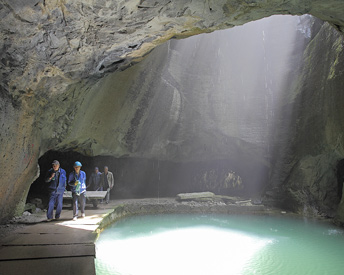History of quarrying
Although there is no historical record of the exact age of the excavation of the stone caves in Changyu area, its history can be roughly divided into five periods according to the analysis of the regional social background, the textual research of historical records and relics, and the textual research methods of surface dating, etc First, the northern and Southern Dynasties - the early stage of strip stone mining in Sui and Tang Dynasties. The development of stone mines in Changyu area began from the Wei and Jin Dynasties more than 1600 years ago. During the northern and Southern Dynasties 1500 years ago, due to the small population and small mining scale, only sporadic quarrying activities began. During the Sui and Tang Dynasties, a large number of immigrants came to Xinhe area, and the agriculture in Changyu area flourished, so the mining scale of slate stone was expanded. In the area of the double gate cave Dengming cave, small-scale quarrying has been carried out. The main quarrying stones are slates with a small amount of slates. The left quarry sites are small-scale open-pit benches and straight holes. The second is the peak period of strip stone and slate mining in Song Dynasty. In the Song Dynasty about 1000 years ago, social and economic development, especially the relocation of capital Lin'an in the Southern Song Dynasty, the southward movement of the center of state power, the rise of water conservancy and transportation, urban construction, and the need for a large number of stones for the construction of seawalls and sluices, finally made the slate stone production in Changyu develop into a unified industry, which gave birth to the arrival of the first peak period of quarrying in Changyu. According to the records of Taiping County in Jiajing, there were 14 Dai (weir dam), 12 gates and 5 bridges. All the building stones they used are breccia tuff in Changyu area. In the area of double gate cave Dengming cave Daoyuan cave, the quarrying scale is large, and the quarrying stones are slates and slates. The remaining quarrying sites are large-scale open-pit benches, straight hole pits and semi open pit bell covered pits. Third, the sporadic mining period in the yuan and Ming Dynasties. After the Song Dynasty, the economy of Changyu declined, the number of people decreased, and the development was slow. During this period, there were only sporadic mining activities, and the stones were mainly used for road and town construction. In the early Ming Dynasty, Japanese invaders disrupted the coast. Zhu Yuanzhang ordered Tanghe, the Duke of the state, to build more than 70 cities along the coast. Slate stones were widely used in Changyu. During the period from mingchenghua to Taiping County, the number of bridges has increased to 79. Fourth, the peak period of slate mining in Qing Dynasty. Over 200 years since Kangxi of the Qing Dynasty, the stone quarrying activities in Changyu have been carried out in the hilly areas. The stone quarrying activities are slate and strip stone, which are mainly used for the construction of towns, temples, houses, water conservancy and roads. The remaining quarrying sites are mainly semi open pit with bell. During the Guangxu period of the Qing Dynasty, water conservancy projects were built again. According to the records of Taiping County in Guangxu, there were 27 gates and 115 bridges at that time. At the same time, the stone carving technology was becoming more and more exquisite, leaving a large number of stone carving works and living utensils, such as stone windows, stone mortar, stone basin, stone roller, etc. the use of stone materials was expanded and the amount of use increased. In August 1839, Li Yutai founded the Changyu stone mine, with 48 miners and an annual output of 9116 Zhang slate. Fifth, modern and modern high-speed mining period. During the period of the Republic of China, there were more than 70 mines. In the 26th year of the Republic of China (1937), Li Mingtao and other 52 people raised 1450 yuan with 145 shares to establish Changyu stone export and use cooperative. In the 28th year of the Republic of China (1939), there were more than 2000 people with an annual output of 144000 stone slabs. In addition to the local demand, the stone slabs produced in Changyu were also sold to Linhai, Huangyan, Ningbo and even Southeast Asian countries. More than 50 years after the founding of the people's Republic of China, due to the demand for large-scale construction of stone, the integration of modern mining technology into the quarrying process, the greatly improved mining and transportation conditions, the greatly increased mining speed and scale, the rapid development of quarrying activities in Changyu, the rapid extension of caves to the interior of the mountain, the formation of a magnificent, complex structure of the mining caves. The quarrying stone is mainly slate, and the left quarrying site is a underground straight hole type and bell type pit connected into a chain. In 1950, more than 500 mu of mines were mined. In 1959, it was renamed the local state-run Changyu stone mine. In 1961, it became a county collective enterprise. In 1983, there were 236 Changyu stone mines, and Wenling Changyu stone mine joint company was established, with more than 7000 practitioners. In the early 1980s, with the rapid development of construction and traffic construction, the renewal of building materials, the decline of slate sales, the rise of stone processing, the main products are slates, block stones, stones, stone powder, granite plate decoration materials, etc. In 1987, there were 150 mines in Changyu stone mine complex, with an annual output of 87000zhang stone slabs and a sales volume of 1.38 million yuan. County stone factory only processes 1.48 million road surfaces. In the late 1980s, with the renewal of building materials (mostly brick and cement products), slate sales began to decline. Since the 1990s, stone has faded out of the construction market, and the scale of stone mining has also been reduced. The scenery of the mining industry is no longer good. The local stone miners have to change their industries, while the stone mines have to recruit migrant workers from other provinces. Up to now, there are few stone mines left. In the late 1990s, stone machining enterprises gradually rose, and the main products are stone bars, block stones, stones, stone powder, stone carving blank stones and plate decorative materials.






